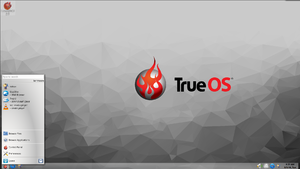PC-BSD
 |
|

Lumina desktop running on TrueOS
|
|
| Developer | iXsystems |
|---|---|
| OS family | Unix-like |
| Working state | Current |
| Source model | Open source |
| Initial release | 2006 |
| Latest release | Rolling Release, based on FreeBSD-CURRENT / September 9, 2016 |
| Package manager | txz & FreeBSD Ports/Packages |
| Platforms | x86-64 |
| Kernel type | Monolithic |
| Default user interface | Lumina |
| License | BSD licenses |
| Official website | trueos |
TrueOS (formerly PC-BSD or PCBSD), is a Unix-like, desktop-oriented operating system built upon the most recent releases of FreeBSD-CURRENT. It aims to be easy to install by using a graphical installation program, and easy and ready-to-use immediately by providing KDE SC, Lumina, LXDE, MATE, or Xfce as the desktop environment. It provides official binary Nvidia and Intel drivers for hardware acceleration and an optional 3D desktop interface through KWin, and Wine is ready-to-use in running of Microsoft Windows software. TrueOS is able to run Linux software, in addition to FreeBSD Ports collection, and it has its own .txz package manager that allows users to graphically install pre-built software packages from a single download link, which is unique for BSD operating systems.
TrueOS supports ZFS, and the installer offers disk encryption with geli so the system will require a passphrase before booting.
TrueOS was originally founded by FreeBSD professional Kris Moore in early 2005 as PC-BSD. In August 2006 it was voted the most beginner friendly operating system by OSWeekly.com.
The first beta of the PC-BSD consisted of only a GUI installer to get the user up and running with a FreeBSD 6 system with KDE3 pre-configured. This was a major innovation for the time as anyone wishing to install FreeBSD would have to manually tweak and run through a text installer. Kris Moore's goal was to make FreeBSD easy for everyone to use on the desktop and has since diverged even more in the direction of usability by including additional GUI administration tools and .pbi application installers. PC-BSD's package manager took a different approach to installing software than many other Unix-like operating systems, up to and including version 8.2, by means of the pbiDIR website. Instead of using the FreeBSD Ports tree directly (although it remained available), PC-BSD used files with the .pbi filename extension (Push Button Installer) which, when double-clicked, brought up an installation wizard program. An autobuild system tracked the FreeBSD ports collection and generated new .pbi files daily. All software packages and dependencies were installed from inside of the .pbi files in their own self-contained directories in /Programs. This convention was aimed to decrease confusion about where binary programs reside, and to remove the possibility of a package breaking if system libraries are upgraded or changed, and to prevent dependency hell.
...
Wikipedia
